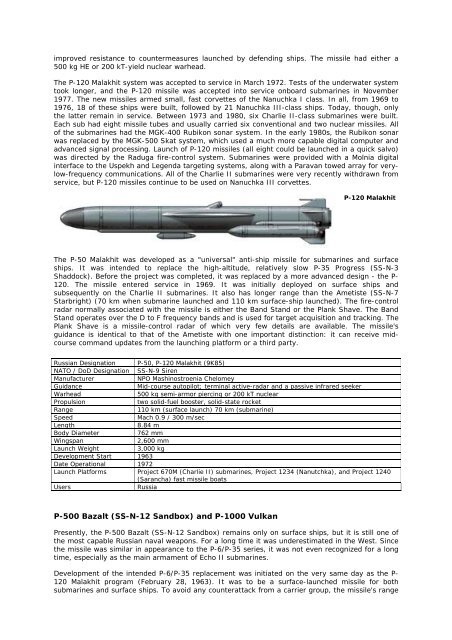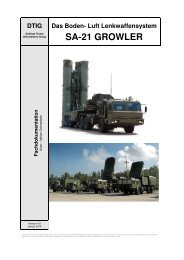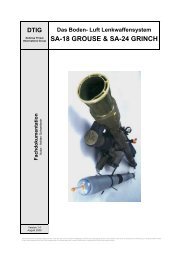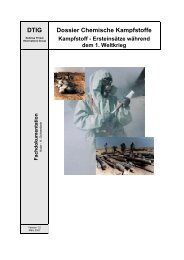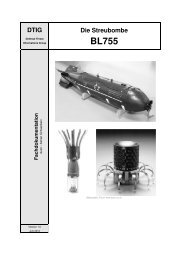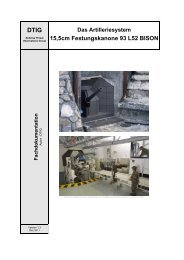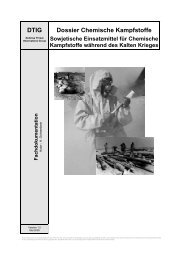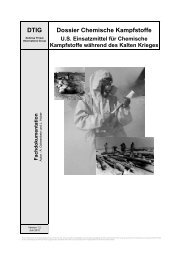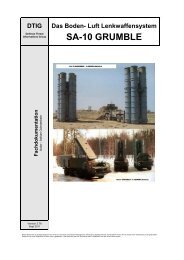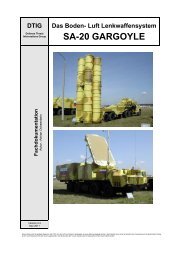RUSSIAN/SOVIET SEA-BASED ANTI-SHIP MISSILES Specia ... - DTIG
RUSSIAN/SOVIET SEA-BASED ANTI-SHIP MISSILES Specia ... - DTIG
RUSSIAN/SOVIET SEA-BASED ANTI-SHIP MISSILES Specia ... - DTIG
Create successful ePaper yourself
Turn your PDF publications into a flip-book with our unique Google optimized e-Paper software.
improved resistance to countermeasures launched by defending ships. The missile had either a<br />
500 kg HE or 200 kT-yield nuclear warhead.<br />
The P-120 Malakhit system was accepted to service in March 1972. Tests of the underwater system<br />
took longer, and the P-120 missile was accepted into service onboard submarines in November<br />
1977. The new missiles armed small, fast corvettes of the Nanuchka I class. In all, from 1969 to<br />
1976, 18 of these ships were built, followed by 21 Nanuchka III-class ships. Today, though, only<br />
the latter remain in service. Between 1973 and 1980, six Charlie II-class submarines were built.<br />
Each sub had eight missile tubes and usually carried six conventional and two nuclear missiles. All<br />
of the submarines had the MGK-400 Rubikon sonar system. In the early 1980s, the Rubikon sonar<br />
was replaced by the MGK-500 Skat system, which used a much more capable digital computer and<br />
advanced signal processing. Launch of P-120 missiles (all eight could be launched in a quick salvo)<br />
was directed by the Raduga fire-control system. Submarines were provided with a Molnia digital<br />
interface to the Uspekh and Legenda targeting systems, along with a Paravan towed array for verylow-frequency<br />
communications. All of the Charlie II submarines were very recently withdrawn from<br />
service, but P-120 missiles continue to be used on Nanuchka III corvettes.<br />
P-120 Malakhit<br />
The P-50 Malakhit was developed as a "universal" anti-ship missile for submarines and surface<br />
ships. It was intended to replace the high-altitude, relatively slow P-35 Progress (SS-N-3<br />
Shaddock). Before the project was completed, it was replaced by a more advanced design - the P-<br />
120. The missile entered service in 1969. It was initially deployed on surface ships and<br />
subsequently on the Charlie II submarines. It also has longer range than the Ametiste (SS-N-7<br />
Starbright) (70 km when submarine launched and 110 km surface-ship launched). The fire-control<br />
radar normally associated with the missile is either the Band Stand or the Plank Shave. The Band<br />
Stand operates over the D to F frequency bands and is used for target acquisition and tracking. The<br />
Plank Shave is a missile-control radar of which very few details are available. The missile's<br />
guidance is identical to that of the Ametiste with one important distinction: it can receive midcourse<br />
command updates from the launching platform or a third party.<br />
Russian Designation P-50, P-120 Malakhit (9K85)<br />
NATO / DoD Designation SS-N-9 Siren<br />
Manufacturer NPO Mashinostroenia Chelomey<br />
Guidance Mid-course autopilot; terminal active-radar and a passive infrared seeker<br />
Warhead 500 kg semi-armor piercing or 200 kT nuclear<br />
Propulsion two solid-fuel booster, solid-state rocket<br />
Range 110 km (surface launch) 70 km (submarine)<br />
Speed Mach 0.9 / 300 m/sec<br />
Length 8.84 m<br />
Body Diameter 762 mm<br />
Wingspan 2,600 mm<br />
Launch Weight 3,000 kg<br />
Development Start 1963<br />
Date Operational 1972<br />
Launch Platforms Project 670M (Charlie II) submarines, Project 1234 (Nanutchka), and Project 1240<br />
(Sarancha) fast missile boats<br />
Users Russia<br />
P-500 Bazalt (SS-N-12 Sandbox) and P-1000 Vulkan<br />
Presently, the P-500 Bazalt (SS-N-12 Sandbox) remains only on surface ships, but it is still one of<br />
the most capable Russian naval weapons. For a long time it was underestimated in the West. Since<br />
the missile was similar in appearance to the P-6/P-35 series, it was not even recognized for a long<br />
time, especially as the main armament of Echo II submarines.<br />
Development of the intended P-6/P-35 replacement was initiated on the very same day as the P-<br />
120 Malakhit program (February 28, 1963). It was to be a surface-launched missile for both<br />
submarines and surface ships. To avoid any counterattack from a carrier group, the missile's range


